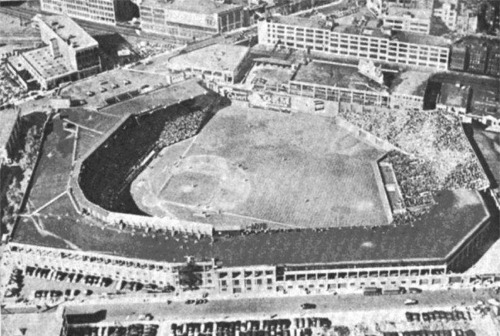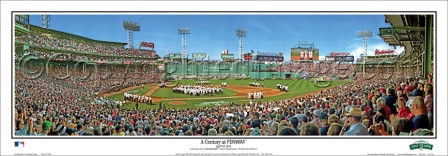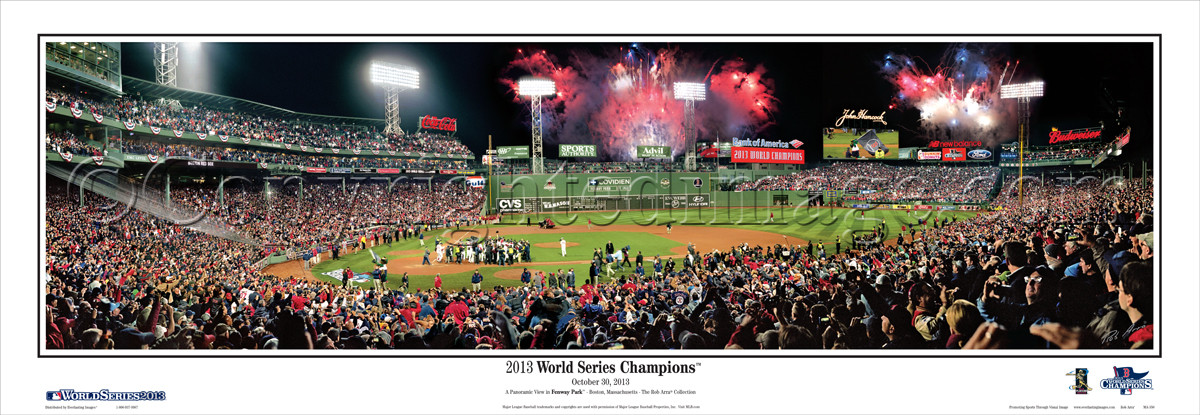|
In today's society
some of the best things are ones that change little and
remain basically the same as they have for decades. Fenway Park is
an example of this as the Boston Red Sox have remained committed to staying at
this classic ballpark that they have called home since 1912. It is
the oldest major league ballpark in use and still retains the same
feel and characteristics as it did when it opened. The history of the Red Sox dates to 1901 when they became a charter member of the American League.
Instead of opting to play at the Boston Braves home, South End
Grounds, the Red Sox, then known as the Americans (1901-1907), built Huntington Avenue Grounds on
site of a wasteland in 1901. This rickety wooden ballpark had a
seating capacity of just over 11,000 and was home to the team for a
decade. Due to the possibility
of
fires and embarrassment to both the team and the City of Boston, Red Sox
owner, John Taylor, decided to build a new ballpark to replace
Huntington Avenue Grounds. Taylor, a real estate magnet, sold
himself a parcel of land in "The Fens" of Boston as a site for a new
ballpark. Construction of the ballpark began in September 1911 and
led to an increase in the value of the team, leading Taylor to sell
the team to Jim McAleer and Robert McRoy.
It took only one year for the ballpark to be built
and on April 20, 1912 the Red Sox played their first
game at Fenway Park against the New York Highlanders
(Yankees). Named after its location, Fenway Park had
a seating capacity of 27,000 with the main steel and
concrete grandstand extending from behind homeplate
down the baselines connecting with wooden bleachers
in the outfield.
Original
dimensions were 321 ft. (left), 488 ft. (center),
and 314 ft. (right), with Duffy's Cliff, a 10 foot
embankment in front of the left field fence.
The 1920s were a low-point for the Red Sox and
Fenway Park. On December 26, 1919 Babe Ruth was sold
to the Yankees and throughout the first half of the
1920s many of the Red Sox's star players were
traded. Fire struck Fenway Park in May 1926
destroying the wooden bleachers in left foul line.
This area was not rebuilt until 1933 when Thomas A.
Yawkey purchased the Red Sox. After the 1933
baseball season, Fenway Park was extensively
renovated.
Duffy’s Cliff was removed, wooden grandstands in
right and center field were replaced by concrete
stands and the entire grandstand was enlarged
increasing the seating capacity to 33,817. The most significant feature added to the
ballpark was the 37 foot high wall in left field. The wall was
covered with advertisements and at the base of the wall was a hand operated
scoreboard. A tragic fire in January 1934 destroyed most of the
construction but the ballpark was complete and free of damage when it reopened on
April 17, 1934. In
1936, a 23 foot net was placed on the left field wall to prevent
baseballs from breaking windows in nearby shops.
Before the start of the 1940 season, the right field
wall was moved in 20 feet shortening the outfield
fence from 325 to 302 feet in right field and 402 to
380 feet in right-center field. Bullpens for the Red
Sox and the visiting team were placed in the area
created between the stands and the outfield wall,
replacing the original ones in foul territory.
The "Green
Monster" was created in 1947 when the advertisements were removed
from the left field wall and it was painted dark green. On
June 13, 1947 the first Red Sox night game was
played at Fenway Park when the team beat the Chicago
White Sox.
For almost three decades there were few changes at
Fenway Park. After the 1975 season a new $1.5
million electronic scoreboard was
erected behind the bleachers in centerfield and the
press box was enlarged, enclosed in glass and
air-conditioned. The same year, the tin that made up the
"Green Monster" was replaced by a hard plastic surface. In
the early 1980s 44 luxury boxes were added at the
ballpark, down the first and third base lines.
Additional seating was also placed along the
right-field roof, creating a small upper deck of
several rows. In 1988 a new color video/scoreboard
was installed replacing the one installed in 1975.
Also, the existing pressbox was replaced with luxury
boxes, known as the 600 Club, and the press area was
rebuilt above the 600 Club.
 Fenway
Park took on its modern day look beginning in 2002
when
John Henry, Tom Werner and Larry Lucchino purchased
the Red Sox. Prior to the team being sold, there had
been discussions of building a new Fenway Park.
However the new ownership group was committed to
preserving and improving Fenway Park. Since 2003, there have been numerous improvements and upgrades completed at
the ballpark. The famous Green Monster seats, 250 bar style seats,
were added atop the Green Monster in left field enabling fans to
view Fenway Park in a different way than the past. In
2004 the Red Sox added
additional seats atop the roof in right field. Two years later, the
once enclosed 606 Club, located behind homeplate, was opened and
features 406 open-air seats.
An additional 400
club seats were added above this area and pavilion level seats,
named the State Street Pavilion, were added along the baselines
increasing the seating capacity
to nearly 38,000. Before the 2008 season, the next phase of upgrades at
Fenway Park was completed. This included the
expansion of the State
Street Pavilion with 800 new seats and the new Coca-Cola Club,
located where the left field foul line meets the Green Monster.
The latest renovations at Fenway Park, completed before the 2009, 2010
and 2011 seasons, involved replacing and
refurbishing seats in the lower bowl. The original 1912 seating bowl was also repaired and
waterproofed. In addition, the seating area along the right Fenway
Park took on its modern day look beginning in 2002
when
John Henry, Tom Werner and Larry Lucchino purchased
the Red Sox. Prior to the team being sold, there had
been discussions of building a new Fenway Park.
However the new ownership group was committed to
preserving and improving Fenway Park. Since 2003, there have been numerous improvements and upgrades completed at
the ballpark. The famous Green Monster seats, 250 bar style seats,
were added atop the Green Monster in left field enabling fans to
view Fenway Park in a different way than the past. In
2004 the Red Sox added
additional seats atop the roof in right field. Two years later, the
once enclosed 606 Club, located behind homeplate, was opened and
features 406 open-air seats.
An additional 400
club seats were added above this area and pavilion level seats,
named the State Street Pavilion, were added along the baselines
increasing the seating capacity
to nearly 38,000. Before the 2008 season, the next phase of upgrades at
Fenway Park was completed. This included the
expansion of the State
Street Pavilion with 800 new seats and the new Coca-Cola Club,
located where the left field foul line meets the Green Monster.
The latest renovations at Fenway Park, completed before the 2009, 2010
and 2011 seasons, involved replacing and
refurbishing seats in the lower bowl. The original 1912 seating bowl was also repaired and
waterproofed. In addition, the seating area along the right
|
|
 |
field
roof was expanded and repaired to seat 575 fans. Prior to the start
of the 2011 season, a new 38'x100' HD video/scoreboard was installed above the center-field bleachers. The current
capacity at Fenway Park is now 37,221 during day games and 37,673 during
night games. The seating capacity varies because a tarp is used
during afternoon games in dead centerfield to provide a backdrop for
hitters. The Red Sox have stated that the seating capacity of
Fenway Park will not exceed 40,000 anytime in the future.Although Fenway Park is
the oldest ballpark in Major League Baseball, it is one of America's
most beloved ballparks. The enthusiastic and exciting atmosphere outside of Fenway Park before
games is truly unique and cannot be found anywhere else. Yawkey Way is closed prior to
every game so fans can mingle and enjoy live music, great food and the
company of other Red Sox fans outside Fenway Park. Inside, Fenway Park's interior is full of character with its small
intimate seating capacity, the Green Monster and manual scoreboard
in left field, the lone red seat in right field where the longest
homerun ever hit, 502 feet by Ted Williams, and the retired numbers
of greats on the right field facade.
It doesn't hurt that the Red Sox have
been one of the best teams in Major League Baseball
over the past decade winning three World Series
Championships in 2004, 2007 and 2013. The 2013 World
Series was even more special to Red Sox fans as the
team clinched the championship at Fenway Park for
the first time since 1918.
|


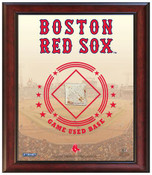


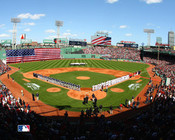


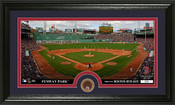

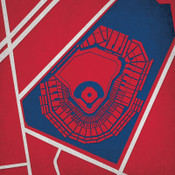
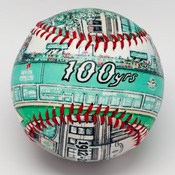
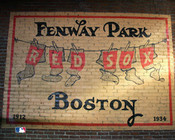
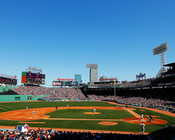




 Fenway
Park took on its modern day look beginning in 2002
when
John Henry, Tom Werner and Larry Lucchino purchased
the Red Sox. Prior to the team being sold, there had
been discussions of building a new Fenway Park.
However the new ownership group was committed to
preserving and improving Fenway Park. Since 2003, there have been numerous improvements and upgrades completed at
the ballpark. The famous Green Monster seats, 250 bar style seats,
were added atop the Green Monster in left field enabling fans to
view Fenway Park in a different way than the past. In
2004 the Red Sox added
additional seats atop the roof in right field. Two years later, the
once enclosed 606 Club, located behind homeplate, was opened and
features 406 open-air seats.
An additional 400
club seats were added above this area and pavilion level seats,
named the State Street Pavilion, were added along the baselines
increasing the seating capacity
to nearly 38,000. Before the 2008 season, the next phase of upgrades at
Fenway Park was completed. This included the
expansion of the State
Street Pavilion with 800 new seats and the new Coca-Cola Club,
located where the left field foul line meets the Green Monster.
The latest renovations at Fenway Park, completed before the 2009, 2010
and 2011 seasons, involved replacing and
refurbishing seats in the lower bowl. The original 1912 seating bowl was also repaired and
waterproofed. In addition, the seating area along the right
Fenway
Park took on its modern day look beginning in 2002
when
John Henry, Tom Werner and Larry Lucchino purchased
the Red Sox. Prior to the team being sold, there had
been discussions of building a new Fenway Park.
However the new ownership group was committed to
preserving and improving Fenway Park. Since 2003, there have been numerous improvements and upgrades completed at
the ballpark. The famous Green Monster seats, 250 bar style seats,
were added atop the Green Monster in left field enabling fans to
view Fenway Park in a different way than the past. In
2004 the Red Sox added
additional seats atop the roof in right field. Two years later, the
once enclosed 606 Club, located behind homeplate, was opened and
features 406 open-air seats.
An additional 400
club seats were added above this area and pavilion level seats,
named the State Street Pavilion, were added along the baselines
increasing the seating capacity
to nearly 38,000. Before the 2008 season, the next phase of upgrades at
Fenway Park was completed. This included the
expansion of the State
Street Pavilion with 800 new seats and the new Coca-Cola Club,
located where the left field foul line meets the Green Monster.
The latest renovations at Fenway Park, completed before the 2009, 2010
and 2011 seasons, involved replacing and
refurbishing seats in the lower bowl. The original 1912 seating bowl was also repaired and
waterproofed. In addition, the seating area along the right

